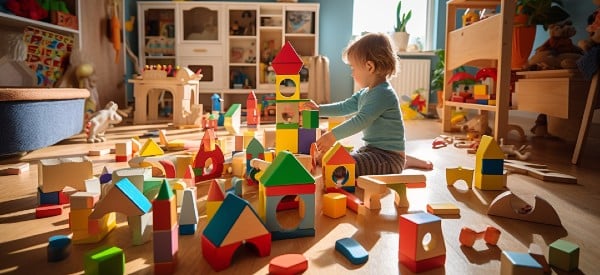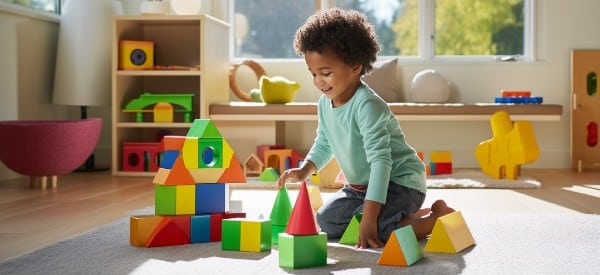Are you ready to embark on a shape-filled adventure with your preschooler?
Get ready to dive into the world of geometry and spatial awareness as you teach your little one about shapes at home.
By introducing shapes in a fun and interactive way, you’ll be helping your child develop crucial skills like problem-solving and critical thinking as they embark on their early childhood learning journey.
So, let’s roll up our sleeves and explore the exciting world of shapes together for young learners!
Get ready, because learning has never been more fun!
Understanding Basic Shapes

To understand basic shapes, you can use materials like toothpicks, pipe cleaners, straws, or craft sticks to create and manipulate shapes at home. It’s a fun and interactive way to learn about circles, squares, triangles, and more!
You can start by taking toothpicks and connecting them to form different shapes. Try making a square by connecting four toothpicks at their ends. Can you make a triangle by connecting three toothpicks? Experiment and see what shapes you can create!
Another activity you can do is using pipe cleaners to make shapes. Twist and bend the pipe cleaners to form circles, squares, and rectangles. You can even combine different shapes to create more complex ones, like a star or a heart.
If you have straws at home, you can cut them into different lengths and use them to build shapes. Connect the straws together with tape or string to make triangles, pentagons, or even hexagons.
Craft sticks are also great for creating shapes. Arrange them to form squares, rectangles, or even a house shape. You can even paint the craft sticks different colors to make the shapes more visually appealing.
1. Explore Shape Recognition
Start by introducing different shapes to your child through everyday objects and activities. Shapes are all around us, and by pointing them out and talking about them, you can help your child develop shape recognition skills.
Here are some fun and interactive ways to explore shape recognition to help your little ones learn STEM for preschoolers:
- Go On A Shape Hunt: Take a walk around your neighborhood or go to a local park and look for different shapes in the environment. Point out shapes in buildings, signs, and even nature. Ask your child to identify the shapes they see and talk about their attributes.
- Play Shape Matching Games: Create a set of shape cards or use objects like buttons or stickers in different shapes. Mix them up and have your child match the objects to the corresponding shape cards. This activity helps reinforce shape recognition and visual discrimination skills. You can also check out other math matching games to help kids understand shapes and learn math at the same time!
- Make Shape Collages: Provide your child with a variety of materials like colored paper, foam shapes, and stickers. Encourage them to create collages using different shapes. As they work, talk about the shapes they are using and ask them to describe the attributes of each shape.
2. Play Shape Games and Puzzles
Playing shape games and puzzles can be a fun and interactive way for you to strengthen your understanding of shapes. By engaging in these shape activities, you can develop your shape recognition skills and learn to identify different shapes in a playful and enjoyable manner.
You can find lots of great STEM math activities for kids with my easy-to-use filtering system to help you find the right activities in a fraction of the time, but here are three exciting ways you can explore shapes through games and puzzles:
- Shape Matching Game: Challenge yourself to match different shapes by turning over cards or flipping puzzle pieces. This game will help you practice visual discrimination and improve your ability to identify and match shapes accurately.
- Shape Sorting Puzzle: Put your problem-solving skills to the test by sorting and classifying shapes based on their attributes. This puzzle will help you understand the properties of different shapes and develop your ability to organize and categorize information.
- Tangram Challenge: Use tangram pieces to create various shapes and figures. This activity will enhance your spatial reasoning skills and encourage you to think creatively as you manipulate the pieces to form different shapes.
3. Create Shape Art Projects
Creating shape art projects is a fun and hands-on way for you to explore and manipulate different shapes. You can let your creativity shine as you use shapes to create beautiful artworks. Here are some exciting ideas to get you started:
- Shape Collages: Cut out shapes from colored paper or old magazines, and glue them onto a larger piece of paper to create a collage. You can arrange the shapes in different patterns and colors to make your artwork unique and eye-catching.
- Shape Stamping: Find objects around your house that have different shapes, like bottle caps or cookie cutters. Dip them in paint and use them as stamps to create shapes on a piece of paper. Experiment with different colors and arrangements to make your own masterpiece.
- Shape Sculptures: Use playdough, clay, or other moldable materials to create three-dimensional shapes. Stack and shape the materials to form different shapes like cubes, spheres, or cones. You can even paint your sculptures once they dry to add more color and detail.
Incorporate Shapes Into Daily Life

When going about your daily routines, look for opportunities to incorporate shapes into everyday shape activities. Shapes are all around you, whether it’s the circle of a plate, the square of a window, or the triangle shape of a road sign.
By pointing out and discussing these shapes with your child, you can help them develop a keen eye for recognizing and identifying shapes in their environment.
For example, while cooking together, talk about the different shapes of ingredients or utensils. When taking a walk outside, point out the shapes of buildings or objects you pass by.
By making shape recognition a part of your daily life, you are providing your child with valuable opportunities to practice and reinforce their understanding of shapes. Plus, it’s a fun and engaging way to make learning shapes a natural part of their world. So, keep an eye out for shapes during your daily routines and watch your child’s shape knowledge grow!
Now that you’ve started incorporating shapes into your daily life, it’s time to take the fun to the next level by playing shape games and puzzles.
Reinforce Shape Concepts Through Books and Songs

Now that you’ve had fun playing shape games and solving puzzles let’s reinforce your shape concepts through preschool shape books and songs!
Books and songs are a great way to engage with shapes while enjoying a story or melody.
When it comes to books, there are many wonderful options available. Look for books that specifically focus on shapes or incorporate shapes into the illustrations. As you read, encourage your child to identify the shapes they see on each page.
You can also ask them questions like, ‘Can you find a circle?’ or ‘How many triangles can you spot?’ This interactive approach will help reinforce their shape-recognition skills.
Songs are another fantastic tool for learning shapes. Look for catchy tunes that teach shapes and encourage your child to sing along. You can even create your own shape songs by incorporating shape names and descriptions into familiar melodies. Singing and dancing to shape songs will make learning even more enjoyable and memorable.
Conclusion
Congratulations! You’ve now mastered the art of teaching shapes to your little ones! By incorporating hands-on shape activities, engaging manipulatives, and real-life exploration, you’ve unlocked a world of geometric wonders.
Remember, shapes are the building blocks of our visual understanding, helping children make sense of the world around them. So go forth and continue to inspire their problem-solving skills, critical thinking abilities, and spatial awareness.
Shape up their minds with fun games, art projects, and catchy songs. The possibilities are endless!
Happy shaping!







0 Comments